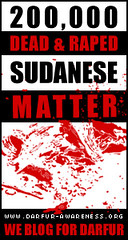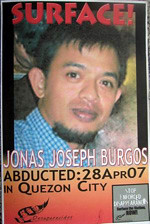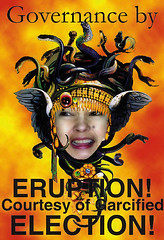Leaving a real legacy: Beyond the spin and the smokescreen
Never mind making everyone rich. Focus on reducing poverty and growing the middle class. That in a nutshell should be the critical benchmark by which an outgoing administration is judged. President Arroyo can spend hundreds of millions putting the most positive spin on her legacy as she packs her bags, but if all indicators point to a burgeoning underclass and a thinning economic middle, then she has failed.
The National Statistical Coordination Board’s (NSCB) calculations point to a less than desirable trend. The gist: as the ranks of high- and middle-income Filipinos slowly dwindle, the low-income class has grown.
How rich is rich in the Philippines? To be considered rich, the NSCB technical staff calculated a cut-off annual family income (for 2010) of at least Php2,393,125 (US$52,024 at Php46=US$1) or a monthly family income of almost Php200,000 (US$4,347 dollars). Based on available data from the Family Income and Expenditures Survey of the National Statistics Office (2000, 2003, and 2006), high-income Filipinos declined from 0.3 percent in 2000 to only 0.1 percent in 2006. In absolute numbers, the Philippine upper crust declined from 51,160 families in 2001 to only 19,738 families in 2006.
But screw the rich. They can help themselves, especially the rags-to-riches characters. They’ll find ways to recover. Let’s turn to the middle and lower classes.
To be considered middle class, a Filipino family must earn between Php294,296 and Php2,393,125 (US$6,397 to US$52,024) per year or a minimum monthly income of Php24,524 (US$533). Between 2000 and 2006, the Philippine middle class declined from 22.7 to 19.1 percent. In absolute numbers, it’s a decrease from 3,422,524 to 3,317,824 families. As tens of thousands of rich Filipinos slipped down one economic rung to the ranks of the middle class, more than 100,000 middle-income families fell through the cracks to join the subterranean underclass.
Needless to say, the biggest swath of the Philippine demographic is comprised of low-income families, defined by the NSCB as families earning less than Php24,524 (US$533) a month. In 2000, they comprised 77 percent of the population. By 2006 (even before the Great Recession), they went up to 80.8 percent. From 11,598,258 families just before Arroyo took office, the number jumped to 14,065, 921 six years hence. That’s a net gain of 2,467,663 new entrants to the low-income block party.
In the absence of official government figures from 2005 to 2010, data from the Social Weather Station’s quarterly Degree of Hunger in Households survey reveal an even bleaker trend. From a total of 10.5 percent hunger incidence in March 2000, the number of cases jumped to 21.2 percent in March 2010. A “hunger incident” is defined as at least one instance, in the last 3 months, in which a family experienced hunger but had no food to eat.
It is most ironic that this economic decline occurred under the watch of a president who taught economics. As senator, President Arroyo worked like a horse, churning out arguably more bills than any of her peers. When she assumed the presidency, however, the string of damning scandals (electoral fraud and corruption) gnawed at her political credibility like terminal cancer, making her a loathed and an ineffective political pariah. She is now succeeded by her economics student, who as a member of the House of Representatives and later of the Senate did not pass any legislation of major import. A new leader with all of the pedigree and an apparent desire to do good but none of the track record will require a solid circle of advisers, certainly not to serve as cordon sanitaire reminiscent of the Cory Aquino administration but to move him, and consequently transform the nation, with the compelling urgency of their ideas.
Six years hence, when the dust will have settled in what will probably be another quintessentially rambunctious cycle of Philippine-style politics, the bottom-line question for the outgoing Noynoy Aquino administration will be as elemental: Did you reduce poverty and grow the middle class? It is the last question to be asked but the first issue he should tackle from Day 1.
************************************************************************The National Statistical Coordination Board’s (NSCB) calculations point to a less than desirable trend. The gist: as the ranks of high- and middle-income Filipinos slowly dwindle, the low-income class has grown.
How rich is rich in the Philippines? To be considered rich, the NSCB technical staff calculated a cut-off annual family income (for 2010) of at least Php2,393,125 (US$52,024 at Php46=US$1) or a monthly family income of almost Php200,000 (US$4,347 dollars). Based on available data from the Family Income and Expenditures Survey of the National Statistics Office (2000, 2003, and 2006), high-income Filipinos declined from 0.3 percent in 2000 to only 0.1 percent in 2006. In absolute numbers, the Philippine upper crust declined from 51,160 families in 2001 to only 19,738 families in 2006.
But screw the rich. They can help themselves, especially the rags-to-riches characters. They’ll find ways to recover. Let’s turn to the middle and lower classes.
To be considered middle class, a Filipino family must earn between Php294,296 and Php2,393,125 (US$6,397 to US$52,024) per year or a minimum monthly income of Php24,524 (US$533). Between 2000 and 2006, the Philippine middle class declined from 22.7 to 19.1 percent. In absolute numbers, it’s a decrease from 3,422,524 to 3,317,824 families. As tens of thousands of rich Filipinos slipped down one economic rung to the ranks of the middle class, more than 100,000 middle-income families fell through the cracks to join the subterranean underclass.
Needless to say, the biggest swath of the Philippine demographic is comprised of low-income families, defined by the NSCB as families earning less than Php24,524 (US$533) a month. In 2000, they comprised 77 percent of the population. By 2006 (even before the Great Recession), they went up to 80.8 percent. From 11,598,258 families just before Arroyo took office, the number jumped to 14,065, 921 six years hence. That’s a net gain of 2,467,663 new entrants to the low-income block party.
In the absence of official government figures from 2005 to 2010, data from the Social Weather Station’s quarterly Degree of Hunger in Households survey reveal an even bleaker trend. From a total of 10.5 percent hunger incidence in March 2000, the number of cases jumped to 21.2 percent in March 2010. A “hunger incident” is defined as at least one instance, in the last 3 months, in which a family experienced hunger but had no food to eat.
It is most ironic that this economic decline occurred under the watch of a president who taught economics. As senator, President Arroyo worked like a horse, churning out arguably more bills than any of her peers. When she assumed the presidency, however, the string of damning scandals (electoral fraud and corruption) gnawed at her political credibility like terminal cancer, making her a loathed and an ineffective political pariah. She is now succeeded by her economics student, who as a member of the House of Representatives and later of the Senate did not pass any legislation of major import. A new leader with all of the pedigree and an apparent desire to do good but none of the track record will require a solid circle of advisers, certainly not to serve as cordon sanitaire reminiscent of the Cory Aquino administration but to move him, and consequently transform the nation, with the compelling urgency of their ideas.
Six years hence, when the dust will have settled in what will probably be another quintessentially rambunctious cycle of Philippine-style politics, the bottom-line question for the outgoing Noynoy Aquino administration will be as elemental: Did you reduce poverty and grow the middle class? It is the last question to be asked but the first issue he should tackle from Day 1.
 Marvin Bionat is the creator of PhilippineUpdate.com, a news and views site that has served as a virtual platform that promotes various advocacies, including the political empowerment of overseas Filipinos and accountability in government. He wrote the National Bookstore bestseller How to Win (or Lose) in Philippine Elections (Anvil Publishing, 1998) and is now based in the
Marvin Bionat is the creator of PhilippineUpdate.com, a news and views site that has served as a virtual platform that promotes various advocacies, including the political empowerment of overseas Filipinos and accountability in government. He wrote the National Bookstore bestseller How to Win (or Lose) in Philippine Elections (Anvil Publishing, 1998) and is now based in the Read more articles by Marvin Bionat
************************************************************************

POGB will not sell, exchange, use or allow any 3rd party access to your email for
any other purposes without exception, email exclusively for article updates only.
























0 Speak Out:
Post a Comment